Article's Content
Myth: People read content on the web.
I hate to break it to you, but people aren’t reading your well-intentioned, meticulously crafted content.
Whether it’s your homepage or your newest blog post, the chances of someone reading every word on the page are actually less than 20%.
People are always in a hurry to find the specific piece of information they’re looking for, so they’ll skip any content that’s irrelevant to their quest.
In fact, if you look at your analytics, I suspect you’ll find that people are spending far less time on your blog posts than it would take to read from start to finish.
On average, people read 200–250 words per minute, so it should take 12–15 minutes for someone to read a 3,000-word blog post.
Are your visitors spending enough time on your page to read the content?
If not, don’t fret!
Now that you know the majority of your visitors are only reading a small portion of the content on any given page, you can shift your writing approach and optimize your content accordingly—which is exactly what I’m going to be talking about in this post.
The reality is that people read content on the web very differently than they do a physical book. If you want people to stay on your website or take a certain action, you need to write in a way that will facilitate that.
This is often referred to as “writing for the web” or “UX writing.”
But before we dig into some writing tips, let’s be clear: The main goal of UX writing isn’t to increase the amount of time that someone spends on your website reading content—although that’s a potential (and likely) result of these efforts.
The main goal of writing for the web is to improve the experience for your audience. Improving their experience is what will keep them engaged on your website and make them more likely to return in the future.
Here’s a list of 15 effective tips on how to write for the web that can help you create a better UX:
- Know your audience
- Have an objective
- Do your research
- Optimize for scanning patterns
- Use white space
- Lead with the most important information
- Use clear headings and subheadings
- Communicate a single idea per paragraph
- Write short sentences and paragraphs
- Use simple words
- Use active voice
- Be specific
- Use visuals to help communicate
- Be clear with your CTA
- Edit ruthlessly
If you want to save these for later or print off a copy to glance at while you’re writing, download the free checklist of these web writing tips!
1. Know your audience
Knowing who will be reading your content is one of the most important ingredients for effective writing. By knowing your target audience, you can write content that actually matters to them.
And you can use the language, tone and style that’s most likely to resonate with them too.
When designing your website, you may have developed personas and journey maps to understand your customer and help you visualize the problems they are trying to solve, the process they go through to find a solution, and the ways they connect with your brand.
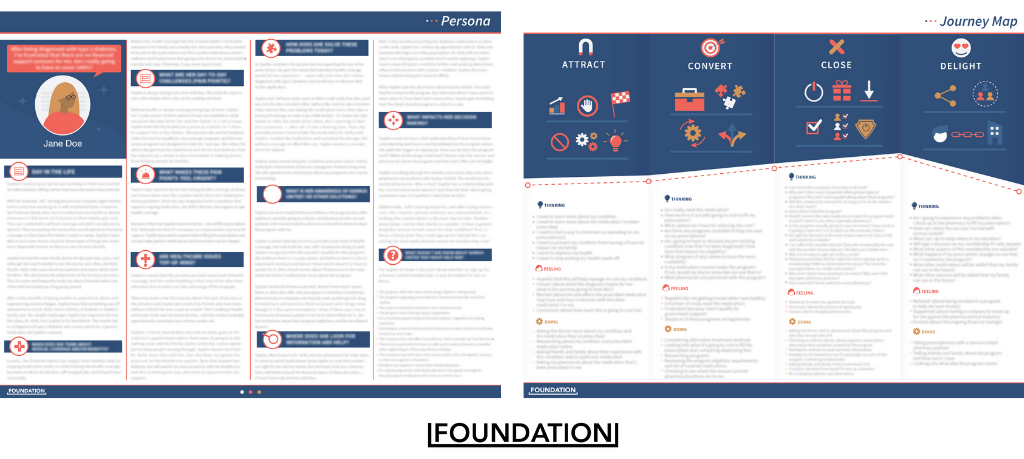
🔑 If you have personas and journey maps, you should dig them up before you start that new blog post or landing page.
If you don’t have personas or journey maps for your audience(s), I would recommend reading our post on the 6 steps to help create your first persona—it explains why you should care about developing personas and outlines six steps to help you get started.
By keeping your audience’s tasks in mind as you write, you can help them accomplish those tasks—giving them a reason to read your content.
2. Have an objective
☝️Before you start writing, have a strong sense of what you want to say and why you want to say it.
Once you have the main topic identified, start building out a framework that outlines the key points you want to communicate. This will help you organize your thoughts and see where you may need supporting sources.
Tip: If you want to cover a complex topic, consider breaking it into a series of posts instead of trying to pack everything into a single post.
As you develop your framework, you should always keep your audience top of mind.
Is your content going to answer any of the questions your audience has on this topic?
Will they get value from reading your post or landing page?
Be honest.
If the answer to either of those is “no,” then now is the time to pivot.

Your framework is also a great place to organize your research findings—read on to see what kind of research you should do as you prepare to write content for the web. ⬇️
3. Do your research
Whenever you’re writing content for the web, you should always conduct 1) keyword research and 2) secondary research.
Keyword Research
Keyword research is incredibly valuable (and necessary) because not everyone communicates the same way you do—your audience may use different words or phrases.
This SEO tactic will tell you what terms or phrases your audience is using to find what they’re looking for—and what you’re writing about.
Whatever your target keyword is, search for longer variations and related questions, then answer those questions in your content. The advantages of this are twofold:
- Your content will answer your audience’s questions, improving their experience
- Your search ranking is likely to improve
For example, those related searches that Google suggests for your target keyword? There’s a good chance Google’s ranking algorithm takes those into account—meaning if your content also includes those terms, your chances of ranking go up.
Once you know what terms and questions your audience is using to search, include those keywords throughout your writing to improve the chances of people finding you organically.
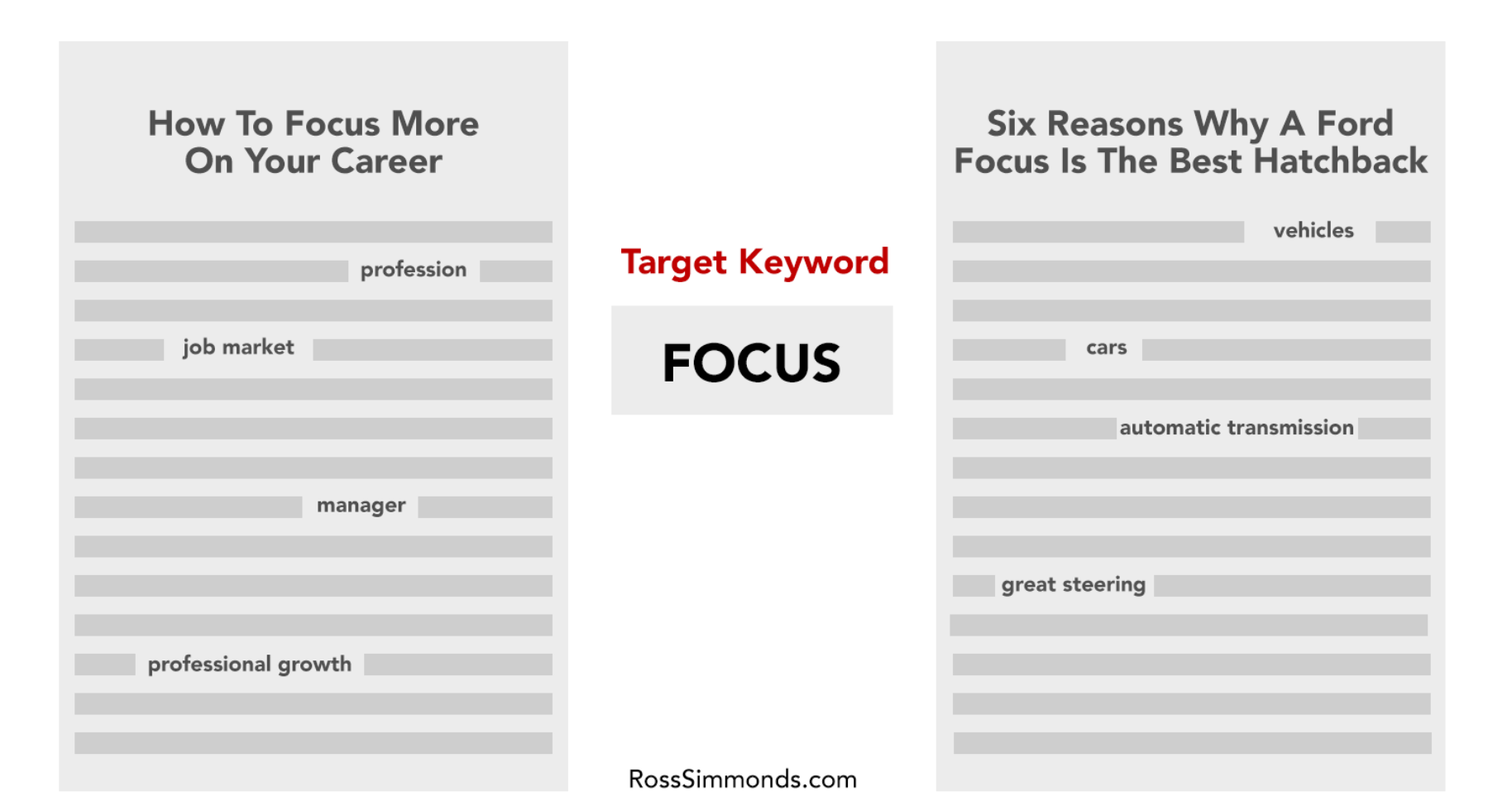
Secondary Research
Adding statistics and research to your blog posts can help validate your point of view. Whatever the topic, you should look for supporting data to build credibility and establish authority.
If you have data to back up the claims you’re making, those claims are going to be a lot more credible.
When possible, link to the original source of a statistic. This means if you find a statistic in a roundup article, click through to the original data source and link out to that in your post.
Another consideration is how old the data is—you should aim for statistics and studies from the last two years. Although this may not always be possible, it’s worth trying to locate the most recent data (especially when it comes to annual reports) to show that your claims are based on current information.
4. Optimize for scanning patterns
After you have an understanding of who will be reading your content, an outline that supports the content’s objective, and research to back up your claims and improve your SEO efforts, then it’s time to build out your content.
According to the Nielsen Norman Group, there are four patterns that people use to scan text on the web. You can optimize your content for these patterns by breaking it into short sections, using meaningful subheadings and visually emphasizing keywords.
Here’s a quick rundown of each content scanning pattern:
F pattern
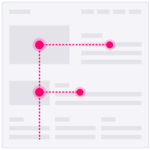
People focus on content in the shape of a capital F—they read text on the left and toward the top of the page more than text on the right or toward the bottom of the page. Given this, it’s a good idea to lead with the most important information.
Spotted pattern

People fixate on specific words or chunks of words throughout the page because 1) the text is styled differently, or 2) the text resembles a word that the reader is looking for to accomplish the task at hand. To make sentences or key messages stand out, try changing colors, using bold formatting or making bulleted lists.
Layer-cake pattern
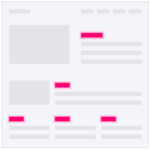
People read the page’s headings and subheadings until they see one they’re interested in. Then they usually read the body text below that heading.
To capture the attention of these readers, use clear headings and subheadings that help them easily identify what each section is about.
Commitment pattern
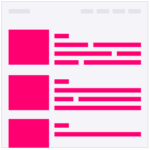
People read all or most of the content on the page—this is traditional reading, not scanning. You find this pattern when the audience is very interested or very motivated to read the content.
5. Use white space
White space refers to the areas of a page that are left blank—in particular, the areas between letters, words, lines or paragraphs.
Using white space makes your writing more inviting and easier to read by visually separating the information.
Even the most complex content can be made more reader-friendly simply by introducing white space.
Using short paragraphs or having more space between your lines of text are easy ways to include more white space in your writing. Also, consider how much space you have framing the content on the left and right of the screen.
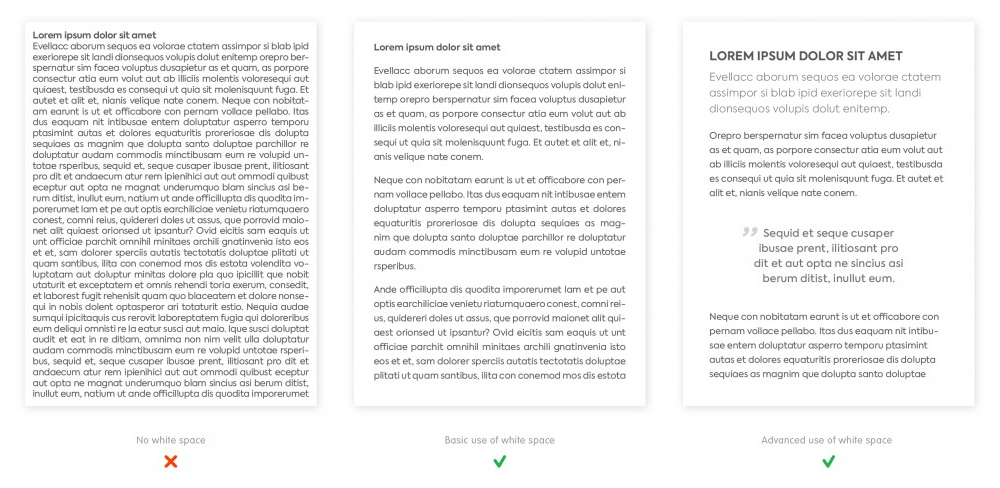
6. Lead with the most important information
Whether you’re writing a blog post or landing page copy, start with the information that is most important to your audience, and then provide additional details. This is an approach commonly used in journalism that is known as the “inverted pyramid.”
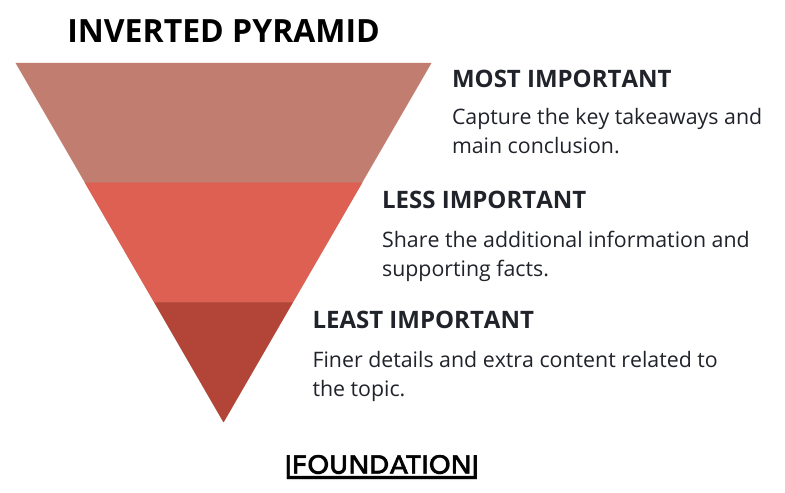
The idea is to start with your conclusion, and then explain how you came to that conclusion.
By front-loading the key information, you give readers the control to find out more if they want to, rather than forcing them to read the full article to get to the conclusion. Keep in mind that online, your audience has the attention span of a goldfish—making them dig for the good stuff will probably make them leave instead.
7. Use clear headings and subheadings
Headings help guide readers through the content.
When headings are clear and descriptive, your audience can find the information they’re looking for more easily, as well as see the relationship between different parts of the content.
Missing the mark on headings and subheadings can make your content seem confusing or irrelevant to your readers—ultimately damaging their confidence in you as a trustworthy or authoritative source of information.
Strong headings are descriptive and concise, giving the reader just enough context to understand what the subsequent information will be about.
Questions make particularly effective headings since your audience is likely searching for answers to those very same questions—that’s what brought them to your content in the first place.
A good test to see whether your headings are clear is to have a colleague scan only the headings (no body copy) of your content. Can they get the gist of what each section is going to be about? If not, make adjustments to any headings that aren’t clear.
Accessibility consideration: Clear headings also help readers who are using assistive technology (e.g., screen readers) to consume your content. When headings are descriptive and use the correct heading tags (e.g., <h1> or <h2>) this ensures that headings make sense when being read out of context. For example, in an automatically generated list of headings/table of contents, or when jumping from heading to heading on a page.
8. Communicate a single idea per paragraph
Keep one idea to one paragraph.
This means exactly what it sounds like: When you’re writing, don’t load a single paragraph with multiple ideas. Keep each paragraph focused on just one idea.
Limiting each paragraph to one idea and multiple pieces of supporting evidence (cue the research you did before you started writing) makes your ideas easier to understand.
As you’re writing, look for paragraphs that seem lengthy or complex. Are there a few ideas blending together and vying for attention? Separate paragraphs into smaller chunks to transition between the different ideas.
For example, the paragraph on the left could be broken out to clearly communicate two separate ideas:
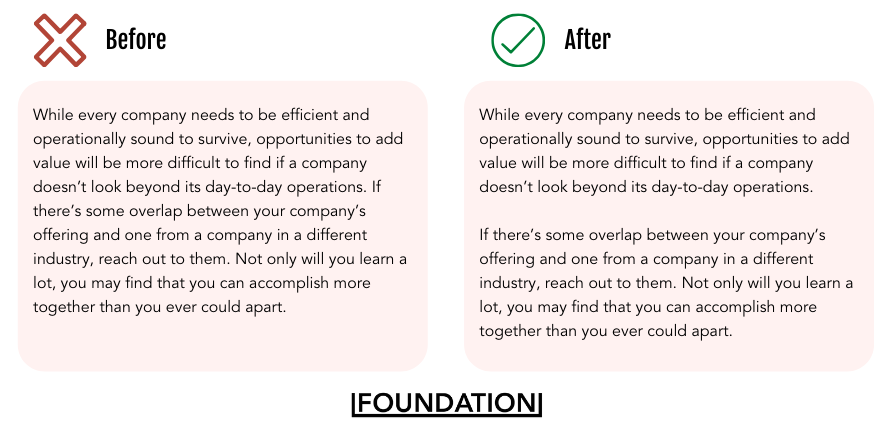
9. Write short sentences and paragraphs
Short sentences and paragraphs help readers absorb information quickly and easily.
Why?
Long paragraphs discourage users from even attempting to read, while short paragraphs are more accessible and easy to digest.
Look at the example below—you can see that the content is much more approachable when it’s broken up into smaller sections:
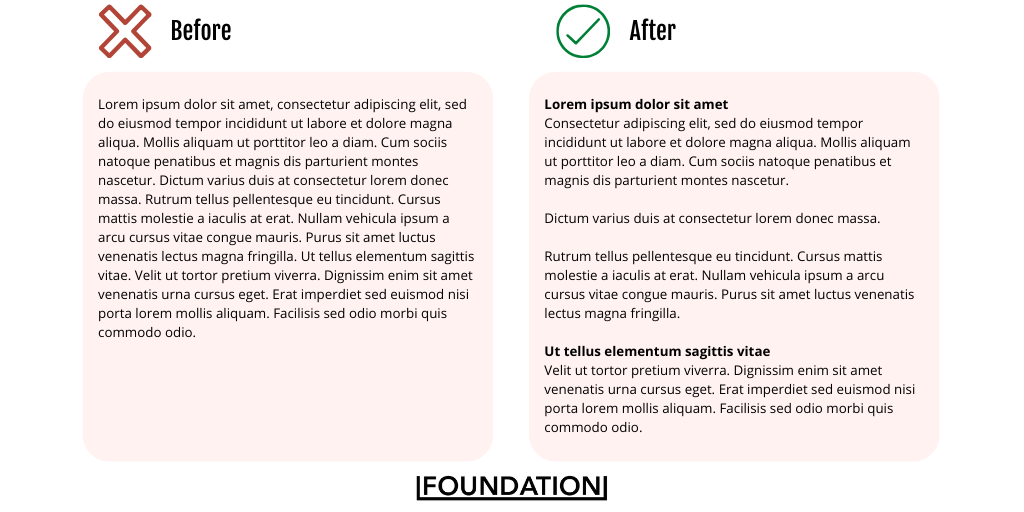
Some best practices for writing short sentences and paragraphs:
- Paragraphs should contain no more than 250 words. (plainlanguage.gov)
- Sentences should use 20 words or less. (usability.gov)
- Each paragraph should be made up of no more than five sentences. (usability.gov)
Now, these are general guidelines and not firm requirements. If your sentence needs 24 words in order to make sense, that’s OK. Just try to keep things on the shorter side where you can.
One-sentence paragraphs are good too—use a brief, punchy sentence to communicate a key point or grab the reader’s attention. For example:
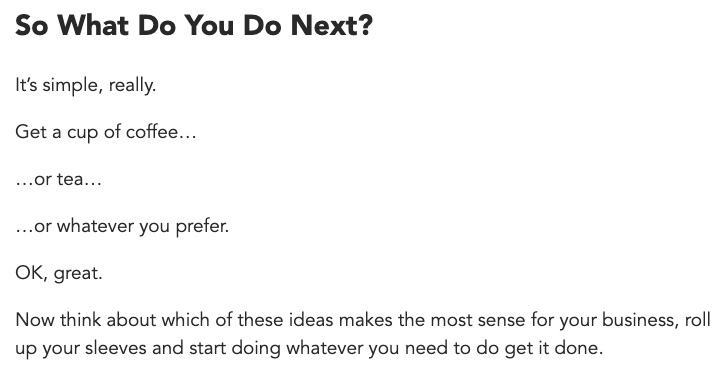
10. Use simple words
When it comes to writing for the web, using the same language as your audience is incredibly important.
By using words your audience is familiar with, your content will be easier to understand and better optimized for search engines.
In place of technical terms, industry jargon or acronyms, use simple and familiar words.
The Hemingway Editor App is a free tool that will highlight lengthy sentences, common errors and complex language in your content. This tool can help you identify areas that seem straightforward to you but may be less approachable for others.
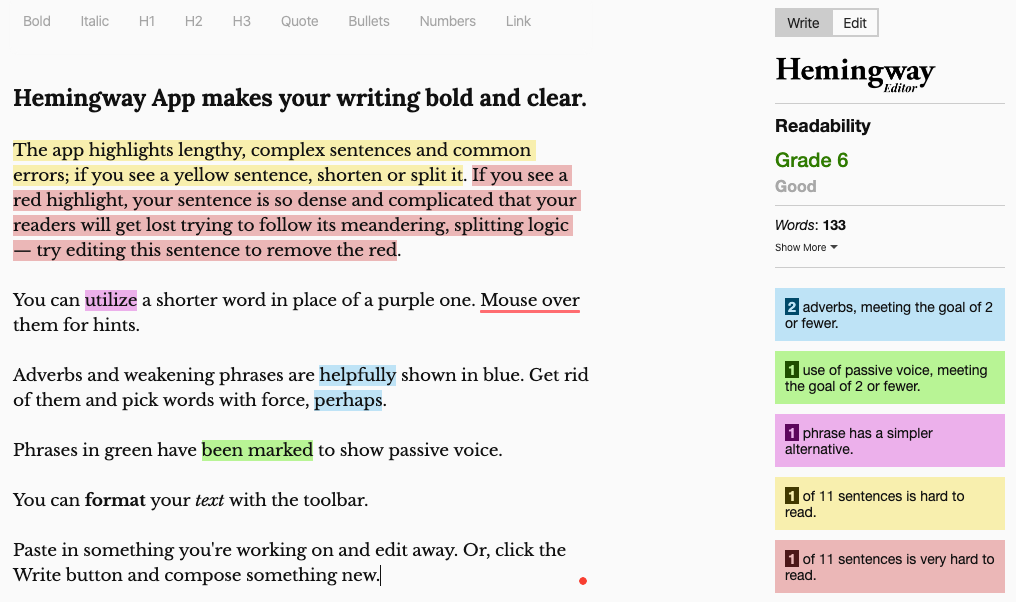
One of the most helpful features of the Hemingway App is the readability level, which indicates the level of education needed to understand the content.
When writing for the web, you should aim for grade 7 or below; however, if you have a very technical audience, it may be appropriate to write for a higher grade level.
11. Use active voice
In sentences with active voice (like this one), the subject acts on the verb. These sentences have a strong, direct and clear tone.
Meanwhile, in sentences with passive voice (like this one), the subject is acted on by the verb. Passive voice is less direct and tends to sound more wishy-washy.
Here are a few more examples:

But let’s be honest—I’m not an expert when it comes to grammar, so if you need further explanation, check out Grammarly’s blog post about active vs. passive voice.
12. Be specific
Whether it’s sample calls-to-action or concrete steps for completing a task, give your readers specific instructions and examples where possible.
Being specific provides context and gives readers a practical understanding of the topic. Otherwise, your content may be too generic for readers to relate to, or they may not know how to apply the key messages to their own situation.
As you write, flag areas where you could incorporate a specific example or offer practical applications. Incorporating more examples into your writing may provide that added value your readers are craving.
13. Use visuals to help communicate
Humans are visual creatures.
Visuals help us learn and give context to what we’re consuming.
Using images, diagrams, gifs or videos to visually represent or expand on your ideas is a highly effective way to communicate with your audience.
If you have a YouTube video that demonstrates the benefits of a resource you’re offering, embed the video on your landing page.
If a diagram would help illustrate a key statistic you’re writing about, find or create one to include in your blog post. To keep the content fresh and engaging, tools that generate AI art can be a smart choice.
When it comes to visuals, here’s a rule to live by: Whatever you include should enhance the reader’s understanding of the content.
Don’t include visuals simply for the sake of including visuals. This is especially true for stock photos—they rarely add value unless you’re actually writing a blog post about stock photos. Don’t assume that adding visuals = adding stock photos and call it a day.
14. Be clear with your CTA
Consuming a piece of content can be like reading a great nonfiction book—the information is valuable, but when you’ve finished you may not be quite sure what to do with your newfound knowledge.
You don’t want to leave your audience wondering what they should do next—you need to tell them what to do.
That’s the purpose of a call-to-action (or CTA). CTAs provide direction, giving your audience the next step to take.
Before you write a CTA, you need to decide what that next step is. Depending on your situation, it might be checking out another piece of content, downloading a related resource, signing up for a demo or trial, or getting in touch with your business.
Whatever step you want readers to take, your CTA should relate to the content they just read and clearly communicate where you’re taking them when they click through—otherwise, they won’t be compelled to click.
Close puts CTAs to good use on their blog by including one at the end of each post to give their readers a clear next step:

15. Edit ruthlessly
No one is a perfect writer. The reality is, the content you publish likely won’t be (and probably shouldn’t be) the first version you wrote.
And you know what? That’s OK.
Any given post you find here in The Lab went through two or three rounds of editing and revisions before it was published. You should put your content through a few rounds of revisions too—you shouldn’t expect your first draft to be perfect.
Here are a few steps to guide your editing process before hitting publish:
- Write the entire post, then set it aside for a few hours (if possible, a few days).
- Read your post with fresh eyes.
- Shorten, delete or rewrite anything that does not add value or clarify your point.
- Get another set of eyes on it. (If you don’t have an editor on your team, send it over to a colleague or friend to get their take.)
- Make revisions based on their feedback.
- Repeat steps 4 and 5 if needed.
Be sure to keep an eye on the “fluff.” The fluff is all those extra words that aren’t really doing anything. Essentially, you should try to use as few words as possible without losing the meaning. Aim to write concisely and efficiently—every word should have a purpose.
Wrapping things up
Whenever someone lands on your blog post or landing page, there are countless distractions vying for their attention.
You have to give them a reason to pay attention to your content instead of everything else out there they could be listening to.
Now that you know people are more likely to scan your content than read it thoroughly, you can use that knowledge to give your audience a better experience—and a reason to stay on the page.
As you optimize your content for the web, you may just see an increase in how long visitors are spending consuming your content. None of us are perfect writers, but leveraging these 15 UX writing tips is a great place to start on the path of providing a better user experience for your readers.
Download the free checklist version of these web writing tips to use as helpful reminders as you write your next blog post or landing page content:
Download A Free Checklist With 15 Web Writing Tips
We’ll send you a downloadable PDF checklist for you to run through every time you publish something new online.
By downloading this resource, you’ll also start receiving a few emails per week on B2B growth and content marketing.








